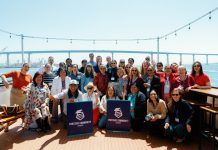During a special Nov. 15 meeting, National City’s Planning Commission approved a Conditional Use Permit allowing San Diego Rescue Mission to develop a transitional housing facility at 2400 Euclid Ave.
The 7.65-acre property, located in a residential neighborhood that borders on the Lincoln Acres currently includes South Bay Community Church, an accompanying watchman’s residence, and a school that is no longer in operation post-COVID.
National City Principal Planner Martin Reeder said the main sanctuary building would be converted to a 160-bed transitional housing facility with an additional eight beds and three private rooms for families established in the watchman’s residence under San Diego Rescue Mission’s plan. Typical services, he said, would include showers, daily meals, laundry services and case management.
San Diego Rescue Mission Chief Executive Officer Donnie Dee said the facility would be similar to one they currently maintain at 120 Elm St. in San Diego as well as a similarly proposed Oceanside facility.
The group takes what he called a “triage” approach, and focuses on temporarily housing unsheltered homeless individuals and families while determining what they need to permanently get them off the streets.
Reeder said the city includes homeless persons as a special needs group under the housing element but the closest homeless shelter is in Chula Vista and homelessness is on the rise.
“Contributing factors to lack of affordable housing is the increase of the population currently below the poverty level or approaching that level, reductions in public subsidies for homeless outreach as well as an increase in untreated mental illness in the area,” Reeder said.
The city doesn’t have anything like this shelter within the land use code, Reeder said, prompting a closer look at potential concerns such as security, litter and loitering, and operations management.
Several residents expressed concern for neighborhood children during the public hearing.
“We find our compassion directed to the children of the neighborhood at this time. The proximity of this location to the elementary school will lead to our children becoming exposed to unknown danger. They will be subjected to an increase in the litter of personal items and refuse, litter of human wastes, and litter of illegal substances and paraphernalia out into the surrounding areas. This location is directly in the path of my children’s walk to school, twice a day they will be forced to experience the negativity that cannot be contained by property lines,” resident Patricia Croizier said. Lincoln Acres resident Michael Mossbarger said hepatitis, shigellosis and COVID-19 are public health concerns in areas where the homeless congregate for services. He circulated a petition in advance of the public hearing in an effort to have city leaders reconsider the location of the facility.
“According to the U.S. Government National Library of Medicine, the homeless population have criminality rates 35 time higher and registered sex offenders twice as high, they test four times higher for HIV and other communicable diseases… This is like placing an aircraft carrier full of a high risk population right across from a preschool and elementary school,” Mossbarger said at the public hearing.
Dee said the fact that National School District Preschool and Lincoln Acres Elementary School are located nearby the site would prevent them from housing any registered sex offenders. However California Supreme Court found proposition 83, which prohibited registered sex offenders from living within 2,000 feet of any school, to be unconstitutional because it potentially limits access to drug and alcohol dependency programs, counseling and other medical treatment.
Dee also said anyone with concerns about the National City site should look to the Elm Street location.
“I have volunteered on and off for more than 20 years with the Rescue Mission. If you go to the downtown location you would see a well maintained and clean building. It is not a place where people loiter outside. For the greater good of our community please say yes to this project,” resident Verna Clark said.
Resident Joan Rincon said she is in favor of the project, in part because it is located on public transportation lines, “enabling a program participant to handle any appointments or needs anywhere in the County that is served by mass transit”.
First Baptist Church of National City Reverend Seth David Clark, who said the organization is a self-funded entity that would help the city address the growing issue of homelessness at no cost to taxpayers.
“Even if the San Diego Rescue Mission wanted to move onto my National City street, I would absolutely be in favor of saying ‘yes’ to their presence,” Clark said.
The site would come with a 24-hour surveillance system, but Planning Commission Chair Maria Dela Paz pushed for clarity of language, and insisted the site be monitored 24 hours a day by an in-person security guard.
“I will hold Mr. Donnie Dee to the words he expressed. It is a very sensitive matter for the residents in the area but also, like our chairman said, we need to address the problem of homelessness,” Planning Committee Member Ditas Yamane said.
Several members of the commission appeared hesitant to move forward without any input from the National City Police Department, who had said they could not send a representative to the meeting but could provide input at a later date.
Ultimately, the Conditional Use Permit was approved with all members in favor except for Planning Commission Vice Chair Ricardo Sanchez.














